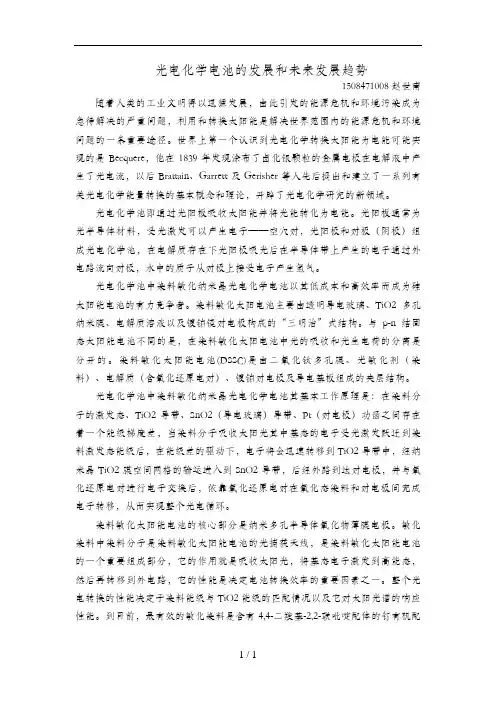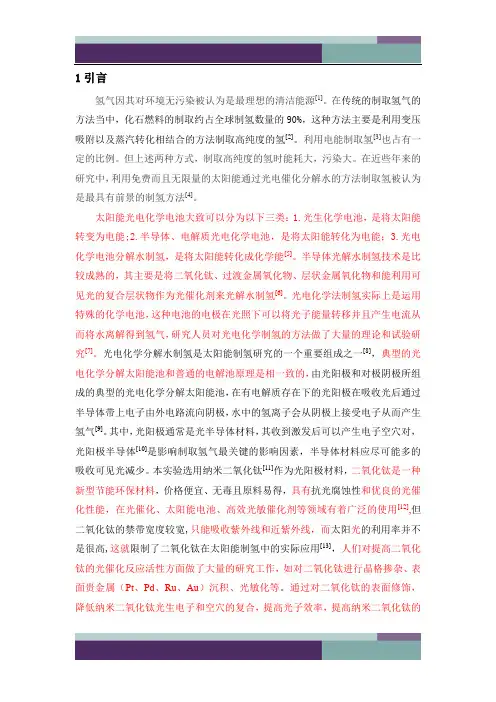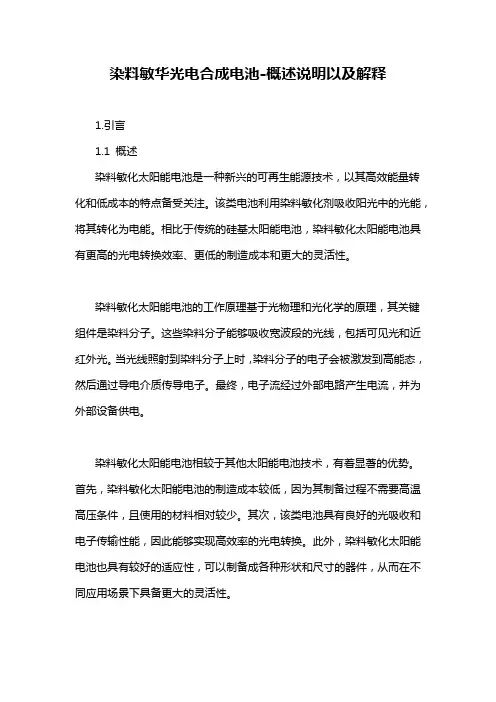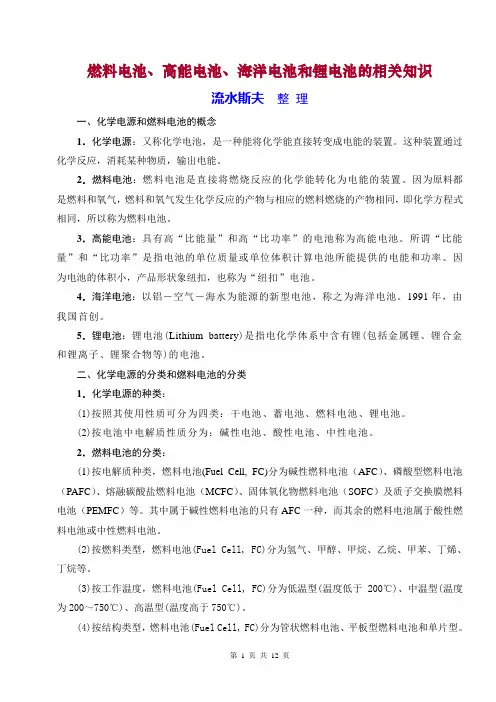光电化学电池(绝密资料)
- 格式:ppt
- 大小:1.16 MB
- 文档页数:14

Electrochem Battery Division Wilson Greatbatch Ltd. 10,000 Wehrle DriveClarence, New York 14031 USA Tel 716-759-5384 Fax 716-759-2562MATERIAL SAFETY DATA SHEETIssued: 10/15/2002Section 1 – IDENTIFICATIONProduct Name:LITHIUM SULFURYL CHLORIDECELLS AND BATTERIESHermetically-Sealed Lithium Sulfuryl Chloride Cells & BatteriesAll Electrochem CSC & PMX Cells and BatteriesSection 2 – COMPOSITION/INFORMATION ON INGREDIENTSSulfuryl Chloride 7791-25-5 TLV/PEL N/ALithium 7439-93-2 TLV/PEL N/AChlorine 7782-50-5 ACGIH: 1.5 mg/m3 TLV/TWA Carbon 1333-86-4 ACGIH: 3.5 mg/m3 TLV/TWASection 3 – HAZARDS IDENTIFICATION**DANGER** INTERNAL CONTENTS ARE EXTREMELY HAZARDOUS. LEAKING FLUID IS CORROSIVE. BATTERY MAY BE EXPLOSIVE AT HIGHER TEMPERATURES.Do not expose to temperatures above the maximum rated temperature as specified by the manufacturer due to leak hazard.If cell or battery leaks or ventsPrimary Routes of Entry: InhalationCarcinogenicity: Not listed by NTP, IARC, or regulated by OSHA.Health Hazards: Acute – Vapors are very irritating to skin, eyes, and mucous membranes. Inhalation of thionyl chloridemay result in pulmonary edema.Chronic – Overexposure can cause symptoms of non-fibrotic lung injury Signs and Symptoms of Exposure: Eye and mucous membrane irritation.Medical Conditions Generally Aggravated by Exposure: Asthma, other respiratory disorders, skin allergies, and eczema.Section 4 – FIRST AID MEASURESEye Contact: Flush with running water for at least 15 minutes. Hold eyelids apart. Seek immediate medical attention. Contact results in acidic burns.Skin Contact: Rinse with large amounts of running water. Avoid hot water and rubbing skin. If burns develop, seek medical attention. Contact results in acidic burns.Inhalation: Remove to fresh air. If breathing is difficult, administer oxygen. If not breathing, give artificial respiration. May result in pulmonary edema.Ingestion: Drink copious amounts of water (or milk if available). Do not induce vomiting. NEVER GIVE ANYTHING BY MOUTH TO AN UNCONSCIOUS PERSON. Immediately seek medical attention.Boiling Point: Thionyl Chloride: 77o CVapor Pressure: Thionyl Chloride: 92mm @ 20°CVapor Density: Thionyl Chloride: 4.1Solubility in Water: Thionyl Chloride: Decomposes violently on contact with water.Specific Gravity: Thionyl Chloride: 1.63Melting Point: Thionyl Chloride: -105°CEvaporation Rate: N/AWater Reactive: Thionyl Chloride hydrolyzes to form SO2 and HCl gasses and strongly acidic wastewater. Appearance & Odor: Thionyl Chloride – Colorless to pale yellow; sharp, pungent odor.OSHA Status: This product is considered an “Article” and the internal component (thionyl chloride) is hazardous under the criteria of the Federal OSHA Hazard Communication Standard 29 CFR 1920.1200.Shipping Requirements: Lithium batteries and cells are subject to the shipping requirements and exceptions under 49 CFR 173.185.All lithium/thionyl chloride cells with a lithium or lithium alloy content of greater than 0.5 are restricted and subject to DOT (49 CFR) and IATA shipping regulations. Cells that contain less than 0.5 grams of lithium or lithium alloy and batteries that contain less than 1.0 grams of lithium or lithium alloy are unrestricted, and they can be shipped by any means [49 CFR 173.185(a)(c)].IATA: Lithium batteries have to be separated to prevent external short circuits, and must be packed in inner fiberboard containers (no more than 500 grams of lithium per inner container). The containers may then be packed with at least one inch of non-combustible packing material (vermiculite) separating each inner package in UN approved fiberboard boxes, steel drums, fiber drums, or wooden boxes. These packages must be printed with a United Nations Marking Symbol (section 6.0 of IATA shipping regulations).Section 16 – OTHER INFORMATIONLithium Battery SafetyWith proper use and handling, lithium batteries have demonstrated an excellent safety record. The success and wide use of lithium batteries is partially due to the fact that they contain more energy per unit weight than conventional batteries. However, the same properties that result in a high energy density also contribute to potential hazards if the energy is released at a fast-uncontrolled rate. In recognition of the high-energy content of lithium systems, safety has been incorporated into the design and manufacture of all Electrochem batteries. However, abuse or mishandling of lithium batteries can still result in hazardous conditions. The information provided here is intended to give users some guidelines to safe handling and use of Electrochem lithium batteries.Cell AbuseIn general, the conditions that cause damage to cells and jeopardize safety are summarized on the label of each cell. These conditions include:• Short Circuit• Charging• Forced Over discharge• Excessive heating or incineration• Crush, puncture or disassembly• Very rough handling or high shock and vibration could also result in cell damage.Cell Handling and Inspection GuidelinesThe most frequent forms of cell abuse can easily be identified and controlled in the workplace. It is our experience that inadvertent short circuits are the largest single cause of field failures.Problems associated with shorting as well as other hazardous conditions can be greatly reduced by observing the following guidelines:• Cover all metal work surfaces with an insulating material.• The work area should be clean and free of sharp objects that could puncture the insulating sleeve on each cell.• Never remove the shrink-wrap from a cell or battery pack.• All persons handling cells should remove jewelry items such as rings, wristwatches, pendants, etc., that could come in contact with the battery terminals.• If cells are removed from their original packages for inspection, they should be neatly arranged to preclude shorting.• Cells should be transported in plastic trays set on push carts. This will reduce the chances of cells being dropped on the floor, causing physical damage.• All inspection tools (calipers, rulers, etc.) should be made from non conductive materials, or covered with a non conductive tape.• Cells should be inspected for physical damage. Cells with dented cases or terminal caps should be inspected for electrolyte leakage. If any is noted, the cell should be disposed of in the proper manner.Cell StorageCells should be stored in their original containers. Store cells in a well ventilated, cool, dry area. Store cells in an isolated area, away from combustible materials. Never stack heavy objects on top of boxes containing lithium batteries to preclude crushing or puncturing the cell case.Handling During Product AssemblyAll personnel handling batteries should wear appropriate protective equipment such as safety glasses.• Do not solder wires or tabs directly to the battery. Only solder to the leads welded to the cell by the manufacturer.• Never touch a cell case directly with a hot soldering iron. Heat sinks should be used when soldering to the tabs, and contact with the solder tabs should be limited to a few seconds.• Cells should not be forced into (or out of) battery holders or housings. This could deform the cell causing an internal short circuit, or fracturing the glass to metal hermetic seal.• All ovens or environmental chambers used for testing cells or batteries should be equipped with an over-temperature controller to protect against excessive heat.• Only precision convection ovens should be used for cell testing. Lesser ovens may exhibit uneven heating and hot spots that can exceed the rated temperature of the battery.• Do not connect cells or batteries of different chemistries together.• Do not connect cells or batteries of different sizes together.• Do not connect old and new batteries together.• Consult Electrochem before encapsulating batteries during discharge. Cells may exceed their maximum rated temperature if insulated.Although we have provided a general overview of lithium battery safety and handling, we urge you to call us with any questions. Our technical services staff will be pleased to assist you with your questions.NFPA RATINGFor cells or battery packs involved in anaccident, cells that have vented, or exploded,follow the North American Emergency ResponseGuide (NAERG) #138.24-HOUR EMERGENCY RESPONSEPHONE NUMBER:(800) 424-9300Prepared by: Matthew FrancoRev. 02b (EINY)Date: 08/15/2002Page 5 of 5。


光电化学电池的发展和未来发展趋势1508471008赵世南随着人类的工业文明得以迅猛发展,由此引发的能源危机和环境污染成为急待解决的严重问题,利用和转换太阳能是解决世界范围内的能源危机和环境问题的一条重要途径。
世界上第一个认识到光电化学转换太阳能为电能可能实现的是Becquere,他在1839年发现涂布了卤化银颗粒的金属电极在电解液中产生了光电流,以后Brattain、Garrett及Gerisher等人先后提出和建立了一系列有关光电化学能量转换的基本概念和理论,开辟了光电化学研究的新领域。
光电化学池即通过光阳板吸收太阳能并将光能转化为电能。
光阳板通常为光半导体材料,受光激发可以产生电子——空穴对,光阳极和对极(阴极)组成光电化学池,在电解质存在下光阳极吸光后在半导体带上产生的电子通过外电路流向对极,水中的质子从对极上接受电子产生氢气。
光电化学池中染料敏化纳米晶光电化学电池以其低成本和高效率而成为硅太阳能电池的有力竞争者。
染料敏化太阳电池主要由透明导电玻璃、TiO2多孔纳米膜、电解质溶液以及镀铂镜对电极构成的“三明治”式结构。
与p-n结固态太阳能电池不同的是,在染料敏化太阳电池中光的吸收和光生电荷的分离是分开的。
染料敏化太阳能电池(DSSC)是由二氧化钛多孔膜、光敏化剂(染料)、电解质(含氧化还原电对)、镀铂对电极及导电基板组成的夹层结构。
光电化学池中染料敏化纳米晶光电化学电池其基本工作原理是:在染料分子的激发态、TiO2导带、SnO2(导电玻璃)导带、Pt(对电极)功函之间存在着一个能级梯度差,当染料分子吸收太阳光其中基态的电子受光激发跃迁到染料激发态能级后,在能级差的驱动下,电子将会迅速转移到TiO2导带中,经纳米晶TiO2膜空间网格的输运进入到SnO2导带,后经外路到达对电极,并与氧化还原电对进行电子交换后,依靠氧化还原电对在氧化态染料和对电极间完成电子转移,从而实现整个光电循环。
染料敏化太阳能电池的核心部分是纳米多孔半导体氧化物薄膜电极。



1引言氢气因其对环境无污染被认为是最理想的清洁能源[1]。
在传统的制取氢气的方法当中,化石燃料的制取约占全球制氢数量的90%,这种方法主要是利用变压吸附以及蒸汽转化相结合的方法制取高纯度的氢[2]。
利用电能制取氢[3]也占有一定的比例。
但上述两种方式,制取高纯度的氢时能耗大,污染大。
在近些年来的研究中,利用免费而且无限量的太阳能通过光电催化分解水的方法制取氢被认为是最具有前景的制氢方法[4]。
太阳能光电化学电池大致可以分为以下三类:1.光生化学电池,是将太阳能转变为电能;2.半导体、电解质光电化学电池,是将太阳能转化为电能;3.光电化学电池分解水制氢,是将太阳能转化成化学能[5]。
半导体光解水制氢技术是比较成熟的,其主要是将二氧化钛、过渡金属氧化物、层状金属氧化物和能利用可见光的复合层状物作为光催化剂来光解水制氢[6]。
光电化学法制氢实际上是运用特殊的化学电池,这种电池的电极在光照下可以将光子能量转移并且产生电流从而将水离解得到氢气,研究人员对光电化学制氢的方法做了大量的理论和试验研究[7]。
光电化学分解水制氢是太阳能制氢研究的一个重要组成之一[8],典型的光电化学分解太阳能池和普通的电解池原理是相一致的,由光阳极和对极阴极所组成的典型的光电化学分解太阳能池,在有电解质存在下的光阳极在吸收光后通过半导体带上电子由外电路流向阴极,水中的氢离子会从阴极上接受电子从而产生氢气[9]。
其中,光阳极通常是光半导体材料,其收到激发后可以产生电子空穴对,光阳极半导体[10]是影响制取氢气最关键的影响因素,半导体材料应尽可能多的吸收可见光减少。
本实验选用纳米二氧化钛[11]作为光阳极材料,二氧化钛是一种新型节能环保材料,价格便宜、无毒且原料易得,具有抗光腐蚀性和优良的光催化性能,在光催化、太阳能电池、高效光敏催化剂等领域有着广泛的使用[12],但二氧化钛的禁带宽度较宽,只能吸收紫外线和近紫外线,而太阳光的利用率并不是很高,这就限制了二氧化钛在太阳能制氢中的实际应用[13],人们对提高二氧化钛的光催化反应活性方面做了大量的研究工作,如对二氧化钛进行晶格掺杂、表面贵金属(Pt、Pd、Ru、Au)沉积、光敏化等。

引言:光电化学电池是一种能将光能直接转化为化学能的装置。
随着对可再生能源的需求日益增长,光电化学电池作为一种新兴的能源转换技术受到了广泛的关注。
本文将就光电化学电池的原理、分类、应用、优势和挑战等方面进行详细阐述。
概述:光电化学电池是基于光电化学效应的装置,它通过将光能转化为电能来实现能源的转换。
在光电化学电池中,光吸收剂吸收光能,利用光生载流子产生电流,并将光能转化为化学能,从而实现能源的转换。
光电化学电池具有高效能转换、环保可持续的特点,因此在可再生能源领域具有广阔的应用前景。
1. 原理光电化学电池的工作原理是基于光电化学效应。
当光照射到光电化学电池中的光吸收剂时,光能被吸收,激发光吸收剂中的电子跃迁到较高能级。
这些激发态的电子被称为光生载流子,可以通过电子传递过程形成电流。
光生载流子可以在电解质中或沉积在电极上参与化学反应,从而将光能转化为化学能。
2. 分类光电化学电池可以根据其光吸收剂的不同来进行分类。
目前常见的光电化学电池有染料敏化太阳能电池、钙钛矿太阳能电池、有机太阳能电池等。
这些不同类型的光电化学电池在光吸收剂的选择和电子传导机制上有所差异,但都利用光生载流子来转化光能为电能。
3. 应用光电化学电池在能源领域具有广泛的应用前景。
太阳能光电化学电池被广泛应用于太阳能发电领域,通过将光能转化为电能来解决传统能源的短缺问题。
此外,光电化学电池还可以在光催化、电解水制氢、二氧化碳还原等领域发挥重要作用。
光电化学电池的应用不仅仅局限在能源领域,还有望在环境治理和光催化反应等方面发挥重要作用。
4. 优势光电化学电池与传统的能源转换技术相比具有许多优势。
首先,光电化学电池是一种可再生能源技术,能够实现光能到电能的高效转换,具有零排放和环境友好的特点。
其次,光电化学电池具有反应速度快、自我修复能力强等优势,有望在工业生产中发挥重要作用。
此外,光电化学电池还具有材料多样性、结构设计灵活等优势,可以满足不同应用场景的需求。

染料敏华光电合成电池-概述说明以及解释1.引言1.1 概述染料敏化太阳能电池是一种新兴的可再生能源技术,以其高效能量转化和低成本的特点备受关注。
该类电池利用染料敏化剂吸收阳光中的光能,将其转化为电能。
相比于传统的硅基太阳能电池,染料敏化太阳能电池具有更高的光电转换效率、更低的制造成本和更大的灵活性。
染料敏化太阳能电池的工作原理基于光物理和光化学的原理,其关键组件是染料分子。
这些染料分子能够吸收宽波段的光线,包括可见光和近红外光。
当光线照射到染料分子上时,染料分子的电子会被激发到高能态,然后通过导电介质传导电子。
最终,电子流经过外部电路产生电流,并为外部设备供电。
染料敏化太阳能电池相较于其他太阳能电池技术,有着显著的优势。
首先,染料敏化太阳能电池的制造成本较低,因为其制备过程不需要高温高压条件,且使用的材料相对较少。
其次,该类电池具有良好的光吸收和电子传输性能,因此能够实现高效率的光电转换。
此外,染料敏化太阳能电池也具有较好的适应性,可以制备成各种形状和尺寸的器件,从而在不同应用场景下具备更大的灵活性。
染料敏化太阳能电池的应用领域广泛,涵盖了光伏发电、太阳能充电设备、建筑智能化等多个领域。
在光伏发电领域,染料敏化太阳能电池可用于大规模的太阳能发电站和户用光伏发电系统,为用户提供绿色、清洁的电力供应。
在太阳能充电设备方面,染料敏化太阳能电池可用于手机、电子设备等便携式设备的充电,实现随时随地的能源补充。
此外,染料敏化太阳能电池还可以集成到建筑物表面,将太阳能转化为电能供应给建筑物内部的电器设备,实现建筑智能化。
综上所述,染料敏化太阳能电池作为一种高效能源转换技术,在可再生能源领域具有广阔的应用前景。
随着材料科学和光电技术的不断发展,染料敏化太阳能电池有望取得更大的突破和进展,为人类提供更多清洁、可持续的能源解决方案。
1.2文章结构文章结构部分的内容可以包括以下内容:本文按照以下结构进行论述:1. 引言1.1 概述:简要介绍染料敏华光电合成电池的背景和意义。

光电化学电池的发展和未来发展趋势1508471008赵世南随着人类的工业文明得以迅猛发展,由此引发的能源危机和环境污染成为急待解决的严重问题,利用和转换太阳能是解决世界范围内的能源危机和环境问题的一条重要途径。
世界上第一个认识到光电化学转换太阳能为电能可能实现的是Becquere,他在1839年发现涂布了卤化银颗粒的金属电极在电解液中产生了光电流,以后Brattain、Garrett及Gerisher等人先后提出和建立了一系列有关光电化学能量转换的基本概念和理论,开辟了光电化学研究的新领域。
光电化学池即通过光阳板吸收太阳能并将光能转化为电能。
光阳板通常为光半导体材料,受光激发可以产生电子——空穴对,光阳极和对极(阴极)组成光电化学池,在电解质存在下光阳极吸光后在半导体带上产生的电子通过外电路流向对极,水中的质子从对极上接受电子产生氢气。
光电化学池中染料敏化纳米晶光电化学电池以其低成本和高效率而成为硅太阳能电池的有力竞争者。
染料敏化太阳电池主要由透明导电玻璃、TiO2多孔纳米膜、电解质溶液以及镀铂镜对电极构成的“三明治”式结构。
与p-n结固态太阳能电池不同的是,在染料敏化太阳电池中光的吸收和光生电荷的分离是分开的。
染料敏化太阳能电池(DSSC)是由二氧化钛多孔膜、光敏化剂(染料)、电解质(含氧化还原电对)、镀铂对电极及导电基板组成的夹层结构。
光电化学池中染料敏化纳米晶光电化学电池其基本工作原理是:在染料分子的激发态、TiO2导带、SnO2(导电玻璃)导带、Pt(对电极)功函之间存在着一个能级梯度差,当染料分子吸收太阳光其中基态的电子受光激发跃迁到染料激发态能级后,在能级差的驱动下,电子将会迅速转移到TiO2导带中,经纳米晶TiO2膜空间网格的输运进入到SnO2导带,后经外路到达对电极,并与氧化还原电对进行电子交换后,依靠氧化还原电对在氧化态染料和对电极间完成电子转移,从而实现整个光电循环。
染料敏化太阳能电池的核心部分是纳米多孔半导体氧化物薄膜电极。


燃料电池、高能电池、海洋电池和锂电池的相关知识流水斯夫整理一、化学电源和燃料电池的概念1.化学电源:又称化学电池,是一种能将化学能直接转变成电能的装置。
这种装置通过化学反应,消耗某种物质,输出电能。
2.燃料电池:燃料电池是直接将燃烧反应的化学能转化为电能的装置。
因为原料都是燃料和氧气,燃料和氧气发生化学反应的产物与相应的燃料燃烧的产物相同,即化学方程式相同,所以称为燃料电池。
3.高能电池:具有高“比能量”和高“比功率”的电池称为高能电池。
所谓“比能量”和“比功率”是指电池的单位质量或单位体积计算电池所能提供的电能和功率。
因为电池的体积小,产品形状象纽扣,也称为“纽扣”电池。
4.海洋电池:以铝-空气-海水为能源的新型电池,称之为海洋电池。
1991年,由我国首创。
5.锂电池:锂电池(Lithium battery)是指电化学体系中含有锂(包括金属锂、锂合金和锂离子、锂聚合物等)的电池。
二、化学电源的分类和燃料电池的分类1.化学电源的种类:(1)按照其使用性质可分为四类:干电池、蓄电池、燃料电池、锂电池。
(2)按电池中电解质性质分为:碱性电池、酸性电池、中性电池。
2.燃料电池的分类:(1)按电解质种类,燃料电池(Fuel Cell, FC)分为碱性燃料电池(AFC)、磷酸型燃料电池(PAFC)、熔融碳酸盐燃料电池(MCFC)、固体氧化物燃料电池(SOFC)及质子交换膜燃料电池(PEMFC)等。
其中属于碱性燃料电池的只有AFC一种,而其余的燃料电池属于酸性燃料电池或中性燃料电池。
(2)按燃料类型,燃料电池(Fuel Cell, FC)分为氢气、甲醇、甲烷、乙烷、甲苯、丁烯、丁烷等。
(3)按工作温度,燃料电池(Fuel Cell, FC)分为低温型(温度低于200℃)、中温型(温度为200~750℃)、高温型(温度高于750℃)。
(4)按结构类型,燃料电池(Fuel Cell, FC)分为管状燃料电池、平板型燃料电池和单片型。
新型的化学电源随着工农业生产和国防建设的迅速发展,人们对化学电源的要求也越来越高,需要制造具有体积、电容量大、质量小和功率大等特点的新型的化学电源。
下面着重介绍两种常用的新型的化学电源。
1.银锌蓄电池银锌蓄电池是一种高能电池。
它的质量小、体积小,是人造地球卫星、宇宙火箭、空间电视转播站等的电源。
银锌蓄电池的负极是锌(Zn),正极是氧化银(Ag2O),用锌酸盐溶液(如H2ZnO2加KOH溶液)作电解质溶液。
放电时,在电极上发生的如下反应:负极(锌片)Zn +2OH-Zn(OH)2 +2e-正极(氧化银)Ag2O+H2O+2e-2Ag+2OH-总反应式Zn+Ag2O+H2O 2Ag+Zn(OH)2银锌蓄电池所蓄的电能很高,但使用期不长,在充电状态下不宜长期保存。
2.锂电池锂电池在较小的体积或质量下能放出较多的电能,放电时电压十分稳定,贮存时间长,能在~温度范围内工作。
可作心脏起搏器、照相闪光灯的电源,如做成纽扣式微型锂电池,可用于电子表、助听器、计算器、电脑以及各种手机等方面。
锂电池是用锂作负极,炭作正极,无机溶剂亚硫酰氯(SO2Cl2)在炭极上发生还原反应,电解质溶液是四氯铝化锂(LiAlCl4)溶解于亚硫酰氯中组成。
它的总反应是锂与亚硫酰氯发生反应,生成氯化锂、亚硫酸锂和硫:8Li+3SO2Cl2=6LiCl+Li2SO3+2S。
总之,改进化学电源的一个重要的任务就是使电源的质量小、体积小和提高能量的转化率。
[参考资料]1、原电池的正负极的判断方法(1)由组成原电池的两极电极材料判断。
一般是活泼的金属为负极,活泼性较弱的金属或能导电的非金属为正极。
(2)根据电流方向或电子流动方向判断。
电流是由正极流向负极;电子流动方向是由负极流向正极。
(3)根据原电池里电解质溶液内离子的定向流动方向判断。
在原电池的电解质溶液内,阳离子移向的极是正极,阴离子移向的极是负极。
(4)根据原电池两极发生的变化来判断。
原电池的负极总是失电子发生氧化反应,其正极总是得电子发生还原反应。
光电化学电解池-概述说明以及解释1.引言1.1 概述光电化学电解池是一种应用光电化学原理进行电解反应的设备。
其基本原理是利用光能激发光敏阴极或阳极表面的半导体材料,使其产生电子与空穴,进而参与电解反应。
光电化学电解池在能源转换、环境修复、化学合成和电化学分析等领域具有广泛的应用。
光电化学电解池的核心是光敏阴极和阳极。
光敏阴极通常采用光催化剂或半导体材料,如二氧化钛、半导体薄膜等。
在受光照射下,光敏阴极吸收光能,激发电子从价带跃迁到导带,形成可用于反应的电子和空穴。
而阳极则是电子通过外电路向阳极迁移的区域。
光电化学电解池的应用领域十分广泛。
在能源领域,光电化学电解池可以通过光能转化为化学能,实现太阳能的有效利用和储存。
在环境修复中,光电化学电解池可以利用光敏阴极的光催化作用,降解有机污染物或去除重金属离子。
此外,光电化学电解池还可用于电化学分析和化学合成等领域。
然而,光电化学电解池也面临一些挑战与优化空间。
首先,光敏材料的选择和合成对光电化学效率有着重要影响,在材料方面的研究还需要进一步深入。
其次,光电化学电解池的稳定性和寿命问题亟待解决,以确保设备的长期可靠性和可持续运行。
此外,光电化学电解池的成本仍较高,需要进一步的技术改进和工艺优化。
综上所述,光电化学电解池是一种应用光电化学原理进行电解反应的设备,具有广泛的应用前景。
然而,其在材料选择、稳定性和成本等方面仍面临一些挑战,需要进行深入的研究和优化。
未来,随着技术的不断进步,光电化学电解池有望在能源转换、环境修复和化学合成等领域发挥更大的作用。
1.2 文章结构文章结构主要分为引言、正文和结论三个部分。
引言部分主要包括概述、文章结构和目的。
概述部分对光电化学电解池进行简单介绍,引起读者的兴趣,并提出该文章的研究内容和重要性。
文章结构部分简要说明文章的组织结构,即引言、正文和结论各部分的内容安排。
目的部分清晰地阐述了本文的主要目标和意义,为读者提供一个整体的了解。
电池通过正负极之间的反应,将化学能转化为电能的装置,即储存化学电能的装置。
自从电池发明至今,已有数百种不同材料、原理、结构的电池。
被广泛应用的充电电池,从材料及原理上分为 3 大类: 1 、铅酸电池, 2 、镍氢电池, 3 、锂电池。
镍铬电池因有记忆,且又不环保已基本被淘汰。
优质电池能达到国家电池标准的主要参数,如电压平台稳定,容量足,使用寿命等电池产品,均为优质电池。
优质电池源自高品质、高纯度的电池材料,最佳电池内部结构设计和先进科学的生产工艺。
优质电池是电池厂追求的目标。
本文所指的电池均为优质电池。
再好的充电方式、使用方式和维护方式均不能将劣质电池变为优质电池。
劣质电池采用二手铅、镍、锂等含杂质很高的低品质金属原料为电池极板,及内部结构、生产工艺均达不到国家电池标准的电池。
劣质电池的特点是:1 、电池电压平台不稳定。
2 、电池容量不足。
3 、电池寿命短。
典型的伪劣电池电池中最高的成本为极板材料铅、镍、锂等金属,这些极板金属的含量实际上决定着电池的容量。
极少数电池厂会通过减少极板金属含量,减薄极板厚度,增加极板反应面积,提高电解液酸度等手法,来增加电池的初始容量,电池寿命通常不会超过 10 个循环次,欺骗用户。
一次电池指无法进行充电,仅能放电的电池。
一次电池容量通常大于同等规格的充电电池。
如锌锰、碱性干电池、锂扣电池等。
一次电池因用电负载不确定,而无法标明实际容量。
如, 8 节一组的一次电池组,仅能为手电钻提供 20 分钟供电,取下的电池却又能为挂钟供电半年以上。
充电电池指可反复充电再循环的电池,电池学称二次电池。
如:铅酸、镍氢、锂离子、锂聚合物等。
电池容量电池充满电后,空载状态下放电至截止电压是所释放的电能量,为电池容量。
一般用符号 mAh 或 Ah 表示。
额定电压电池正负极的材料因化学反应而造成的电位差,而由此产生的电压差,为额定电压。
电池的额定电压分为:过充电压和过放电压。
过充电压充电电池充电至最高的额定电压为过充电压。